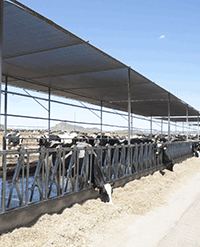 Frazer Certified Public Accountants and Consultants, LLP prepare accounting records for dairy operations in seven western states – Washington, Oregon, California (three regions), Idaho, Arizona, New Mexico and in the Texas Panhandle. They have worked with dairy clients for 60 years and these figures represent over 300,000 dairy cows with herd production averages at 21,927 pounds (no breed differentiations).
Frazer Certified Public Accountants and Consultants, LLP prepare accounting records for dairy operations in seven western states – Washington, Oregon, California (three regions), Idaho, Arizona, New Mexico and in the Texas Panhandle. They have worked with dairy clients for 60 years and these figures represent over 300,000 dairy cows with herd production averages at 21,927 pounds (no breed differentiations).Their recent report, ending December 31, 2012, compares the last three years of dairy financial data. They share the calculations on a per-head basis, as well as a per-hundredweight basis. When displaying these figures, it allows producers and their advisers to look for efficiencies (and inefficiencies) in the operations and hopefully find areas to make improvements.
Larger herds rely heavily on their financial records as even pennies, when multiplied over time, and cow numbers can make big differences. The herds analyzed in this report average 1,944 cows, while all herds in the West average 800 cows per dairy. So, this data focuses on some of the largest herds' financials. However, operations of all sizes can draw comparisons and conclusions from the reports.
In their 2011 summaries, all regions showed a profit, although $6 yearly profit per head in Southern California two years ago is hardly deserving of a fist pump. However, in 2012 only the Northwest (Oregon and Washington) and Idaho were in the black. Feed costs were the main culprit. In the Northwest, a slight elevation in feed of $24 per head was seen in 2012, while Kern County in Central California saw a colossal jump of $527 per head due to feed issues.
As feed prices rise, producers further scrutinize their management. Cows that are not turning a profit are culled, and nearly half of the herd turned over in the San Joaquin Valley in 2012. The Pacific Northwest turns over herds at a slower rate of 32.3 percent. All regions saw higher turn over rates last year.
Southern California lost a net average of $341 per head per month in 2012. But, when only considering milking cows, the loss was reduced to a $31 per head per cow loss. For the average Southern California dairy in this report, that was a loss of nearly $80,000 last year. Purchased feed is a huge contributor … feed was over 70 percent (grain was over 48 percent) of the cost of producing milk in Southern California. Without the ability to grow feedstuffs, these operations suffer. Other than feed, labor and cost of replacements were the highest input costs.
With milk income under $17 per hundredweight for all regions of California, other states did a shade better, hitting the $18 range for Arizona, Idaho, New Mexico, Oregon and Washington. The Panhandle was the winner with $19.05 per hundredweight, but still producing milk at a loss of $1.12 per milking cow.
Geographic location will not predict financial success. Neither will gross income or culling strategies. Dairies have survived in a variety of locations for numerous reasons. There is not, and most likely will not be ideal locations and conditions to maximize dairy profitability, but we all need to understand the circumstances other producers face.

The author is the online media manager and is responsible for the website, webinars and social media. A graduate of Modesto Junior College and Fresno State, she was raised on a California dairy and frequently blogs on youth programs and consumer issues.








